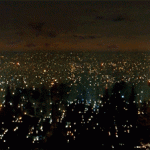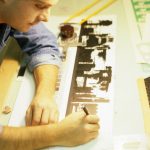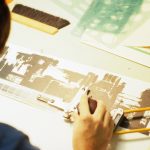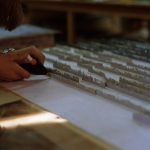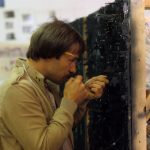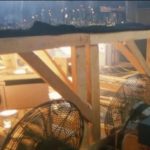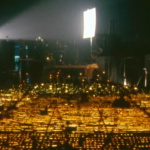things-u-people-wouldnt-believe:
things-u-people-wouldnt-believe:
Entertainment Effects Group.
Blade Runner.
Hades Landscape.The combination of the best distance, camera angles and perspective were the major tricks employed in deceiving the eyes of the audience from seeing the shots of the Hades Landscape miniature scenes as mere photographs.
The sequence was created using a forced-perspective miniature built on a 15ft x 8ft wood table, cut in sections. The detail comes mainly from hundreds of rows of acid-etched brass hand drawn silhouettes inspired from photos taken of towers, pipes, tubes, and other industrial skylines they could find in several El Segundo and Torrance industrial parks from the 80′s. Those brass pieces were arranged on Plexiglas sheets and cast foam foundation and supplemented with painstaking model making of buildings and small structures to fit in-between the brass silhouette rows. Only the front buildings closer to the lens are fully-detailed three dimensional miniatures.
The idea of detailing only the front quarter of the Hades miniature models is an interesting approach which is similar to those used in computer generated 3D models today. In CG, low poly 3D models are often used in places where detailed information is not very important or in areas that are out of the focus of the CG camera.
Then, the lighting was added. The Plexiglas foundation had photofloods beneath it. There was a single Xenon strong source of light from below the miniature. Next, tiny bulbs the size of grains of wheat were put at different areas of the miniature. Other parts of the miniature that were seen to have required further lighting were illuminated with tens of thousands of ultra-thin-fiber-optic strands. The process involved feeding one thing edge of the fiber optic cable in to the area of the miniature to be lit and the other edge into a light box that had a small bulb in it. Twenty boxes were used and once the light bulbs in the boxes were turned on, they would carry light through the fiber optic cables. In order to simulate the different colours of light, the tips of the fiber optic cables that went into the rooms were coloured with different shades of red, yellow and orange using gel filters, allowing for all the windows you see in the scene, as well as helping to define the pyramid in the background, that was made with small wood cutout pieces. The footage of the flame in the Hades Landscape was obtained by Bob Spulock and his crew as they filmed some 35mm explosions in a car park at night, and the explosions were taken from pyrotechnics shot in the California desert for another movie Trumbull worked on, but did not see through to the end. Both elements were then optically added by means of cover mattes and rear projection on white paper cards.
The thick atmosphere was also an idea Trumbull had used before in Close Encounters Of The Third Kind, and it works to good effect here too. The use high density smoke helps to define the layers, while taking advantage of a lot of lights underneath the table to give the right glowing effect of a bustling future Los Angeles.
Basically, the miniature sets were put in a room filled with vaporised oil and was filmed. However, the camera was controlled remotely from another room as the smoke was said to be hazardous to the camera operators. Trumbull and his crew also had to deal with a considerable amount of heat from the sheer number of lights being used to lit the model. They even had to bring in fans to keep everything cool and the room at a temperature they could work in, and bee-smoke puffers wired to modified domestic smoke detectors to measure and regulate the right balance of smoke needed for the filming operation.
The success of the filming of the Hades Landscape was the proper use of front projection techniques and motion control passes to enhance the miniatures.
The basic technology behind motion control photography is the use of a camera that is electronically and mechanically manipulated in capturing different scene objects on the same piece of film at different times. The same movement is precisely repeated a number of times in filming other objects or scenes depending on the nature of what is required.
The principle of front projection works by placing a camera and a projector at right angles to each other. A special mirror that reflects half of the incident rays and allows the other half of the light to pass through it is then place between the camera and the projector. When the projector is switched on, half of the light from the projector goes through the mirror and passes through while the remaining half is reflected off unto the mirror, foreground elements and a reflective screen on the stage. The reflective screen that is placed of the stage reflects and redirects the light through the path it came through the first time. The redirected light travels back through the mirror and is seen by the lens of the camera. The camera records the image it sees from its point of view and all shadows caused by the reflective mirror are not seen from the camera’s point of view because objects perfectly cover their shadows.
The motion controlled camera EEG used in most VFX sequences in Blade Runner was a bulky 65mm 8-channel computer controlled camera, named the “Icebox” by the crew. Basically, the camera was programmed to record the miniature elements in a pass and other elements such as smoke and lighting effects in other passes. The film would then be rewound after each pass and the subsequent passes are recorded on the same piece of negative. In filming the miniature sets however, the camera had a fixed focal length and the miniatures were designed for the field of view of the camera. The procedure was running the sequence with a timer, shot a pass, rewind and repeat as many times as needed. Then, develop the film (about 8-10 hours of waiting time) and see if the shot was a successful one. If not (or if the film was damaged from the rewinding), the crew had to repeat the whole operation, day after day until the shot was done.
